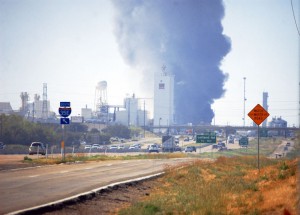Posts Tagged ‘Chemical Accidents’
Testimony From Magnablend Explosion Trial: “Heavy Metal Lids Flapping Up and Down”
 Do you remember the Magnablend explosion in Waxahachie in October of 2011? It quickly enveloped the entire facility and created clouds of black smoke that wafted all the way to Dallas. Run-off from the water used to control the fire killed hundreds, if not thousands, of fish in a near-by creek.
Do you remember the Magnablend explosion in Waxahachie in October of 2011? It quickly enveloped the entire facility and created clouds of black smoke that wafted all the way to Dallas. Run-off from the water used to control the fire killed hundreds, if not thousands, of fish in a near-by creek.
Magnablend was not a chemical manufacturer. It mixed chemicals already made into new combinations for different industries, including the oil and gas industry, pool companies, etc. It did this not all that far from central Waxahachie.
This last week saw testimony about the conditions leading up to the fire in a trial where Magnablend (now called Lifoam Industries) employee James Barron alleges he suffered injuries from inhalation, including brain damage, headaches, balance problems and shortness of breath. His doctor diagnosed him with encephalopathy and high cortical dysfunction caused by exposure to carbon monoxide fumes in the fire.
Following his doctor's diagnosis, Barron's attorney cross-examined Brent Asbill, a supervisor on duty the day of the fire, and asked him to describe the situation that lead to the explosion and fire.
"Asbill said on the day of the accident there was a new chemical tank to blend the product in that had no cooling jacket, thermometer of adequate suppression. Asbill said he was able to get a thermometer installed on the tank by maintenance personnel but the other concerns he reported to his supervisor. His supervisor then made a call to another boss to explain Asbill’s concerns, but Asbill was told to proceed with blending the product. Cole asked if Magnablend had required him to read any of the material safety data sheets that were on file. Asbill said no."Cole then asked Asbill to describe come of the conditions, once he knew something in the blending process appeared to be wrong. Asbill said the heavy metal lid on top of the tank was flapping up and down which indicated that tank had pressure. The vapor produced from the chemical reaction made it appear as if it was raining inside the building. Also electrical equipment started to arc and short out."
Despite these conditions, and evacuation still wasn't ordered until after the explosion. Testimony by other employees and contractors indicate that there was only a single fan providing any kind of ventilation for the blending operation.
Testimony from the trial shines a harsh light on two or three realities in the chemical business. First, it's employees who are often on the front line of health effects from these kinds of facilities, whether through routine exposure of chemicals or catastrophic accidents. But Magnablend had no union looking out for employees, and you'd be hard-pressed to find any union representation in the chemical industry outside the traditionally-union friendly Gulf Coast. Could such an accident have happened in a union shop? Sure. But it's less likely because more boxes have to be checked and there are more rules designed to protect the employees.
Second, the rules and regulations on paper governing an industry don't always mean much in the day-to-day operation of a facility like this – not huge enough to warrant official concern from EPA or OSHA most of the time, but large enough to cause a huge ecological and public health threat if something goes wrong. Industry can't be "over-regulated" if current regulations are not being enforced.
Finally, despite assurances, things can and do go wrong in the field. Whether it's on a fracking rig, a chemical plant, or a cement kiln, human beings find it difficult to be perfect 100% of the time and when you're dealing with unforgiving processes or technology that leave little room for error, things will sometimes go horribly wrong.
That's not an argument to ban such industrial activity, but it's a compelling argument to locate these kinds of facilities away from people.
